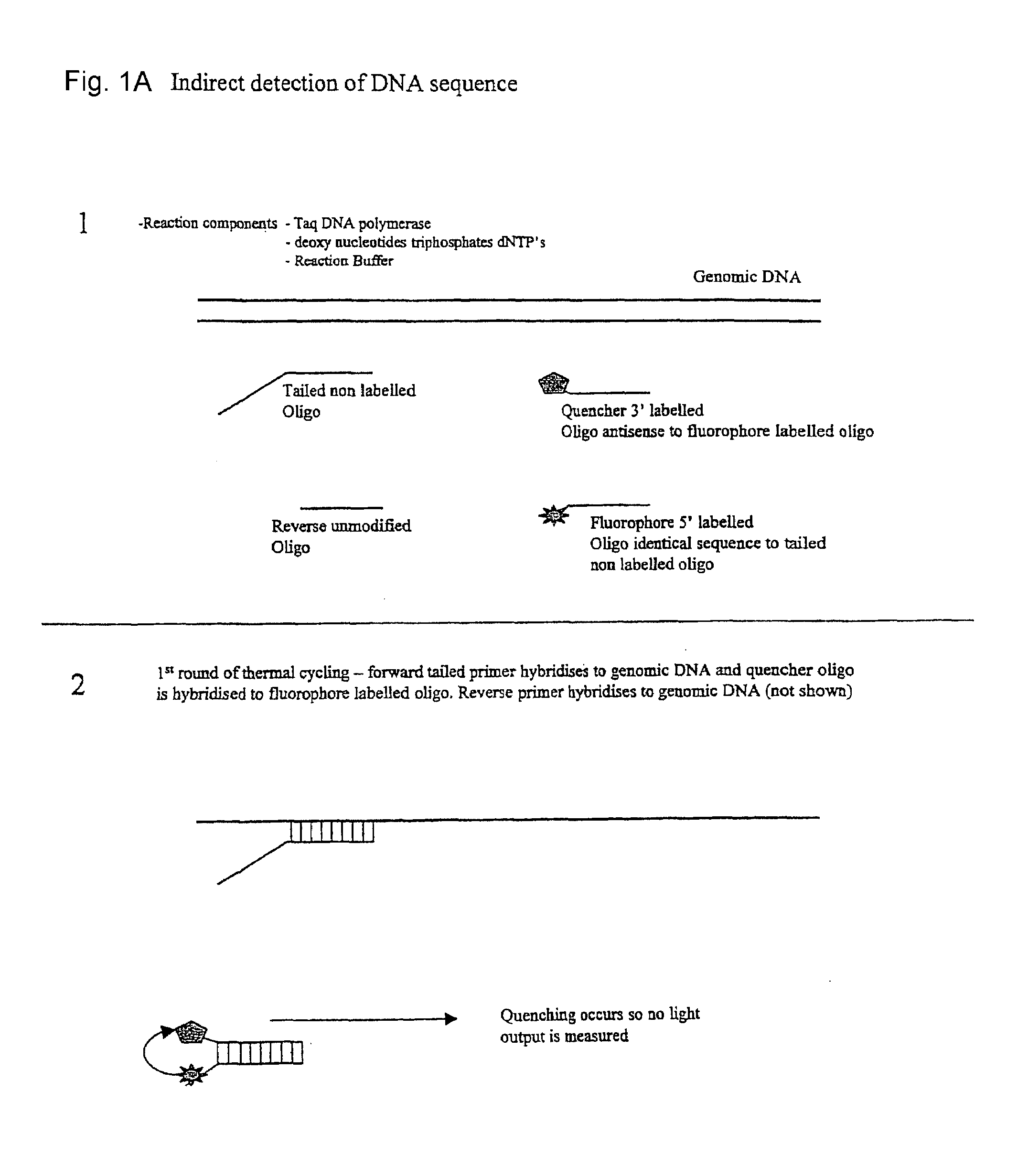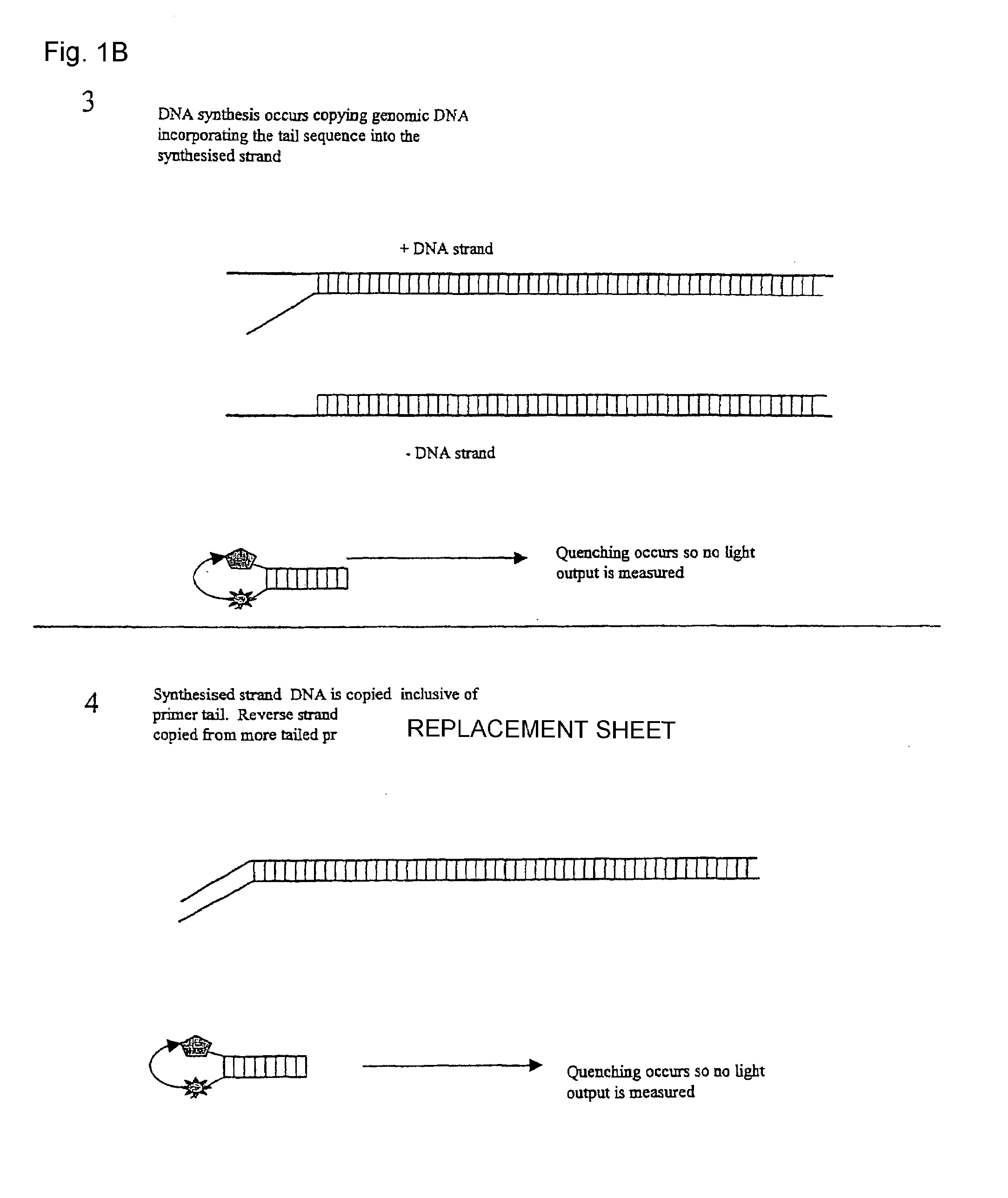Detection system for PCR assay
a detection system and technology of pcr, applied in the field of new fluorescence resonance energy transfer (fret)based detection system, to achieve the effect of improving the effectiveness of the technique, reducing the cost of synthesis, and facilitating synthesis
- Summary
- Abstract
- Description
- Claims
- Application Information
AI Technical Summary
Benefits of technology
Problems solved by technology
Method used
Image
Examples
embodiment 1
Use in Indirect Detection of PCR Products
[0024]This embodiment, illustrated in FIG. 1 hereinafter, utilises a conventional oligo (primer) to initiate the PCR process. This conventional primer is tailed with a DNA sequence that is not directed to the amplicon region of interest, whereby this tail is essentially inert. This tail sequence is positioned at the 5′ portion of the primer. The 3′ portion of the primer is directed to the amplicon region of interest and therefore drives the specificity of the reaction. Also included in the reaction is a single fluorescent-labelled Oligo that is identical in sequence to the tail region of the conventional primer. A number of suitable fluorophores exist, with a popular choice being Fam (a derivative of fluorescein). Finally, included in the reaction is a 3′ quencher labelled Oligo antisense to the Fam labelled Oligo. A number of suitable labels exist of which the Black Hole quencher series of labels are a popular choice.
[0025]Due to the complem...
embodiment 2
End Point Analysis of Allele Specific SNP Genotyping
[0026]This embodiment, illustrated in FIG. 2, utilises the same fluorophore / quencher Oligo pair as in the first embodiment. The reaction schema is identical but for a few modifications.
[0027]To achieve SNP Genotyping requires the use of two fluorescent-labelled primers and corresponding quencher Oligos. Each primer is again tailed with a unique sequence, to which in the reaction is included a 5′ fluorescent labelled primer. Two suitable dyes are Fam and Joe, both derivatives of Fluorescein but spectrally resolvable from each other. The two primers (non tailed portion) are (generally termed forward) directed to the DNA of interest. In this portion of the primer they typically differ only by a single nucleotide at their 3′ terminal base. Each primer is directed to the polymorphic base in the DNA of interest. PCR is conducted and the two primers only initiate synthesis when the 3′ base is perfectly matched. When a mismatch occurs synt...
embodiment 3
Direct Detection of PCR Products
[0029]Specific Detection of PCR products is the most robust method for ensuring the accurate monitoring of a presence of DNA region of interest. The Taqman assay is one of the most widely used methods however it is expensive to perform, due to the requirement for double labelled probes.
[0030]It is possible using the current invention of separating the probe into two single labelled Oligos to perform Taqman assays thereby overcoming this cost limitation. The Taqman assay is a trademark name for the 5′ nuclease assay. The 5′nuclease assay utilises the 5′-3′ exonuclease activity of DNA polymerases and more specifically Taq polymerase. During the PCR if the enzyme encounters a probe sequenced annealed to the amplicon to be copied it displaces the probe and degrades it. This degradation is monitored by the use of FRET as previously described. A simple schema for this embodiment is illustrated in FIG. 3.
[0031]To perform a 5′ nuclease assay with this inventi...
PUM
| Property | Measurement | Unit |
|---|---|---|
| optimal excitation wavelength | aaaaa | aaaaa |
| Tm | aaaaa | aaaaa |
| Tm | aaaaa | aaaaa |
Abstract
Description
Claims
Application Information
 Login to View More
Login to View More - R&D
- Intellectual Property
- Life Sciences
- Materials
- Tech Scout
- Unparalleled Data Quality
- Higher Quality Content
- 60% Fewer Hallucinations
Browse by: Latest US Patents, China's latest patents, Technical Efficacy Thesaurus, Application Domain, Technology Topic, Popular Technical Reports.
© 2025 PatSnap. All rights reserved.Legal|Privacy policy|Modern Slavery Act Transparency Statement|Sitemap|About US| Contact US: help@patsnap.com



